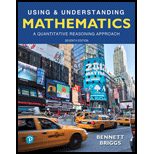
Concept explainers
How Close Was 2016? Consider Table 12.3 which shows the results of the 2016 presidential election in Pennsylvania, Michigan, and Wisconsin.
a. If Clinton had won Pennsylvania, Michigan, and Wisconsin, what would the final electoral vote result have been?
b. What was the total popular vote difference in these three states for the top two candidates?
c. Suppose there had been runoff elections between Trump and Clinton in those three states, and that all of the voters who originally selected other candidates then voted for either Trump or Clinton. For each of the three states, calculate the percentage of the votes for other candidates that Clinton would have needed to have won in order to have won the statewide vote.
Want to see the full answer?
Check out a sample textbook solution
Chapter 12 Solutions
Using & Understanding Mathematics: A Quantitative Reasoning Approach (7th Edition)
- Conjecture Let x and y be integers. If x is even and y is odd, then xy is even. Try some examples. Does the conjecture seem to be true or false?arrow_forwardFind the general solution to the differential equationarrow_forward3. A room has a large circular table with ten seats, numbered 1 to 10, such that to the right of seat number i is seat number i + 1 for all i ∈ {1, . . . , 9} and to the right of seat 10 is seat 1. We want to assign seats to 10 people, 6 of them only speak Slovene, 1 of them only speaks English, and the remaining 3 speak both Slovene and English, by giving out numbered place cards. In how many ways can we do that so that everyone sits next to at least one person who speaks a common language?arrow_forward
- charity savings Budget for May travel food Peter earned $700 during May. The graph shows how the money was used. What fraction was clothes? O Search Submit clothes leisurearrow_forwardExercise 11.3 A slope field is given for the equation y' = 4y+4. (a) Sketch the particular solution that corresponds to y(0) = −2 (b) Find the constant solution (c) For what initial conditions y(0) is the solution increasing? (d) For what initial conditions y(0) is the solution decreasing? (e) Verify these results using only the differential equation y' = 4y+4.arrow_forwardSOLVE ONLY FOR (L) (M) AND (O)arrow_forward
- Aphids are discovered in a pear orchard. The Department of Agriculture has determined that the population of aphids t hours after the orchard has been sprayed is approximated by N(t)=1800−3tln(0.17t)+t where 0<t≤1000. Step 1 of 2: Find N(63). Round to the nearest whole number.arrow_forward1. A telegraph can transmit two different signals: a dot and a dash. We want to encode the 26 letters of the English alphabet and the ten digits 0, 1, 2, . . . , 9 using sequences of these two symbols. What is the smallest integer n such that we can encode all these letters and digits with sequences of length at most n and length at least 1?arrow_forwardUse the graph of y = f(x) to answer the following. 3- 2 -4 -2 -1 1 2 3 4 -1 2 m -3- + (d) Find all x for which f(x) = -2. If there is more than one value, separate them with commas or write your answer in interval notation, if necessary. Select "None", if applicable. Value(s) of x for which f(x)=-2: | (0,0) (0,0) (0,0) (0,0) 0,0... -00 None (h) Determine the range of f. The range is (0,0) Garrow_forward
- File Preview A gardener has ten different potted plants, and they are spraying the plants with doses of Tertizers. Plants can receive zero or more doses in a session. In the following, we count each possible number of doses the ten plants can receive (the order of spraying in a session does not matter). (a) How many ways are there if there were twelve total doses of a single type of fertilizer? (b) How many ways are there if there are six total doses of a single type of fertilizer, each plant receives no more than one dose? (c) How many ways are there if is was one dose of each of six types of fertilizers? (d) How many ways are there if there are four doses of fertilizer #1 and eight doses of fertilizer #2? (e) How many ways are there if there are four doses of fertilizer #1 and eight doses of fertilizer #2, and each plant receives no more than one dose of fertilizer #1? (f) How many ways are there to do two sessions of spraying, where each plant receives at most two doses total?arrow_forward3. [-/3 Points] DETAILS MY NOTES SCALCET8 7.4.032. ASK YOUR TEACHER PRACTICE ANOTHER Evaluate the integral. X + 4x + 13 Need Help? Read It SUBMIT ANSWER dxarrow_forwardEvaluate the limit, and show your answer to 4 decimals if necessary. Iz² - y²z lim (x,y,z)>(9,6,4) xyz 1 -arrow_forward
 Big Ideas Math A Bridge To Success Algebra 1: Stu...AlgebraISBN:9781680331141Author:HOUGHTON MIFFLIN HARCOURTPublisher:Houghton Mifflin Harcourt
Big Ideas Math A Bridge To Success Algebra 1: Stu...AlgebraISBN:9781680331141Author:HOUGHTON MIFFLIN HARCOURTPublisher:Houghton Mifflin Harcourt

 Glencoe Algebra 1, Student Edition, 9780079039897...AlgebraISBN:9780079039897Author:CarterPublisher:McGraw Hill
Glencoe Algebra 1, Student Edition, 9780079039897...AlgebraISBN:9780079039897Author:CarterPublisher:McGraw Hill



